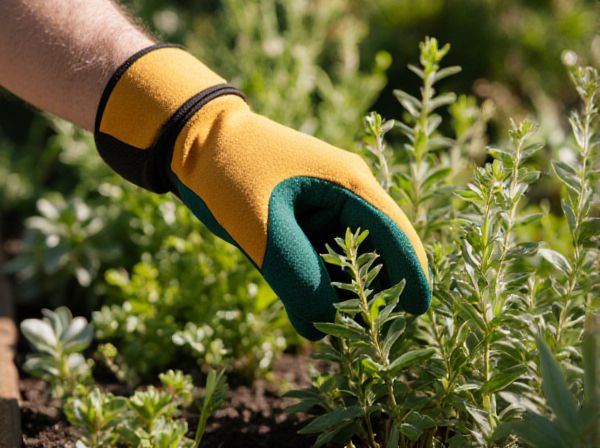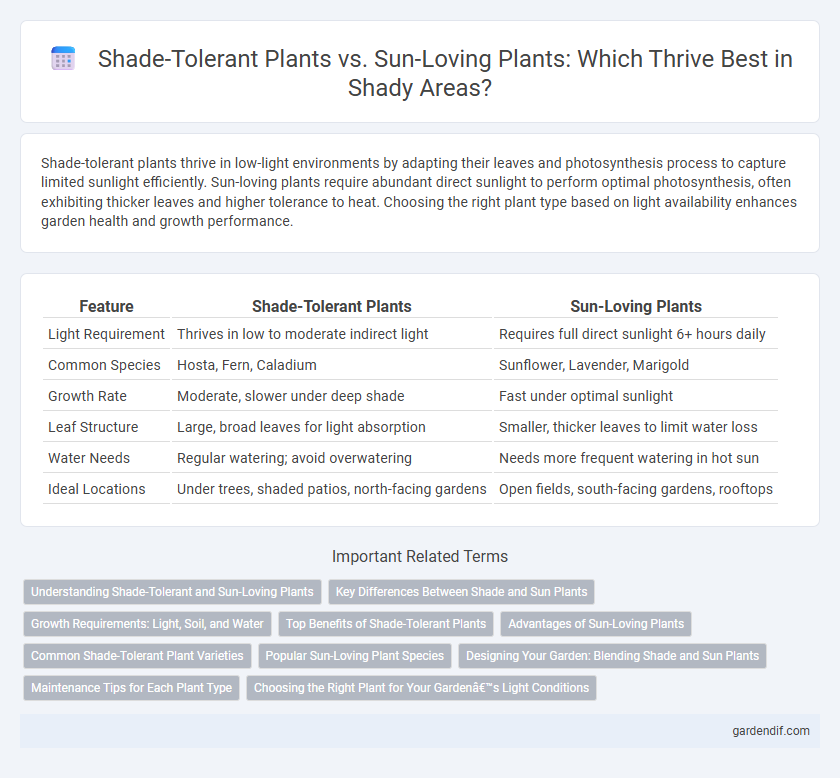
Shade-Tolerant Plants vs Sun-Loving Plants Illustration
Shade-tolerant plants thrive in low-light environments by adapting their leaves and photosynthesis process to capture limited sunlight efficiently. Sun-loving plants require abundant direct sunlight to perform optimal photosynthesis, often exhibiting thicker leaves and higher tolerance to heat. Choosing the right plant type based on light availability enhances garden health and growth performance.
Table of Comparison
| Feature | Shade-Tolerant Plants | Sun-Loving Plants |
|---|---|---|
| Light Requirement | Thrives in low to moderate indirect light | Requires full direct sunlight 6+ hours daily |
| Common Species | Hosta, Fern, Caladium | Sunflower, Lavender, Marigold |
| Growth Rate | Moderate, slower under deep shade | Fast under optimal sunlight |
| Leaf Structure | Large, broad leaves for light absorption | Smaller, thicker leaves to limit water loss |
| Water Needs | Regular watering; avoid overwatering | Needs more frequent watering in hot sun |
| Ideal Locations | Under trees, shaded patios, north-facing gardens | Open fields, south-facing gardens, rooftops |
Understanding Shade-Tolerant and Sun-Loving Plants
Shade-tolerant plants thrive in low-light environments by adapting their leaf structure and chlorophyll concentration to maximize photosynthesis under reduced sunlight. In contrast, sun-loving plants require ample direct sunlight to perform optimal growth, relying on high light intensity for energy production and flowering. Understanding these adaptations aids in selecting the appropriate vegetation for specific garden conditions, ensuring plant health and growth efficiency.
Key Differences Between Shade and Sun Plants
Shade-tolerant plants have adapted to thrive with limited sunlight, often exhibiting larger, thinner leaves to maximize light absorption and slower growth rates to conserve energy. In contrast, sun-loving plants require full sunlight for photosynthesis, characterized by smaller, thicker leaves and faster growth cycles to utilize abundant light efficiently. Key differences include light requirements, leaf morphology, and growth habits, which determine their optimal planting conditions and overall health in landscapes.
Growth Requirements: Light, Soil, and Water
Shade-tolerant plants thrive in low-light environments, requiring well-drained, nutrient-rich soil and moderate water to prevent root rot, whereas sun-loving plants need full sunlight, often demanding more frequent watering and soil with excellent drainage to support rapid growth. Light intensity influences chlorophyll production and photosynthesis efficiency, with shade plants adapting broader leaves to capture limited light, in contrast to sun plants having smaller, thicker leaves to reduce water loss. Soil moisture retention and composition are critical, as shade-tolerant species prefer consistent moisture but less direct sun exposure, while sun-loving plants demand soil that dries quickly to avoid fungal diseases.
Top Benefits of Shade-Tolerant Plants
Shade-tolerant plants thrive in low-light conditions, making them ideal for landscaping shaded areas where sun-loving plants struggle to grow. These plants enhance garden diversity, improve soil erosion control, and reduce water consumption due to their adaptability to limited sunlight. Incorporating shade-tolerant species like hostas, ferns, and astilbes boosts ecosystem resilience and creates lush, visually appealing green spaces in predominantly shaded environments.
Advantages of Sun-Loving Plants
Sun-loving plants thrive in full sunlight, promoting vigorous growth and vibrant flowering due to higher photosynthesis rates. These plants typically require less frequent watering as direct sunlight enhances soil evaporation, reducing the risk of root rot. Their ability to produce abundant blooms and fruits makes them ideal for gardens seeking bright, colorful displays and increased yields.
Common Shade-Tolerant Plant Varieties
Common shade-tolerant plant varieties such as Hostas, Ferns, and Heucheras thrive in low-light environments where sun-loving plants like Lavender and Roses struggle to grow. These shade-tolerant species adapt to limited sunlight by maximizing chlorophyll efficiency and developing broader leaves for enhanced photosynthesis. Selecting shade-tolerant plants ensures lush, vibrant garden spaces even under dense tree canopies or shaded patios.
Popular Sun-Loving Plant Species
Popular sun-loving plant species such as roses, lavender, and marigolds thrive in full sunlight, requiring at least six hours of direct sun daily to optimize photosynthesis and bloom production. These plants develop vibrant colors and robust growth by harnessing ample solar energy, making them ideal for open gardens and sunny landscapes. Unlike shade-tolerant plants, sun-loving species often exhibit higher drought resistance due to their adaptation to intense light and heat conditions.
Designing Your Garden: Blending Shade and Sun Plants
Designing a garden that blends shade-tolerant plants with sun-loving varieties requires understanding light requirements and spatial placement to optimize growth. Shade-tolerant plants like hostas, ferns, and astilbes thrive under tree canopies or shaded corners, while sun-loving plants such as lavender, roses, and marigolds flourish in full sunlight exposure. Strategically placing these plants to complement natural light patterns enhances biodiversity and creates visually appealing transitions between shaded and sunny areas.
Maintenance Tips for Each Plant Type
Shade-tolerant plants require consistent moisture and well-draining soil to prevent root rot, while minimizing fertilizer to avoid excessive growth in low light conditions. Sun-loving plants thrive with full sunlight exposure and benefit from regular watering combined with nutrient-rich soil to support vigorous growth. Proper mulching and pruning enhance airflow and reduce pest risks for both plant types, tailored to their specific light and water needs.
Choosing the Right Plant for Your Garden’s Light Conditions
Selecting the right plant for your garden depends on understanding light requirements, with shade-tolerant plants thriving in low-light environments while sun-loving plants need direct sunlight to flourish. Shade-tolerant species like hostas, ferns, and impatiens excel under tree canopies or shaded patios, offering lush foliage despite limited sun exposure. In contrast, sun-loving plants such as tomatoes, lavender, and sunflowers require at least six hours of full sun daily to maximize growth and flowering potential.
Shade-Tolerant Plants vs Sun-Loving Plants Infographic

 gardendif.com
gardendif.com